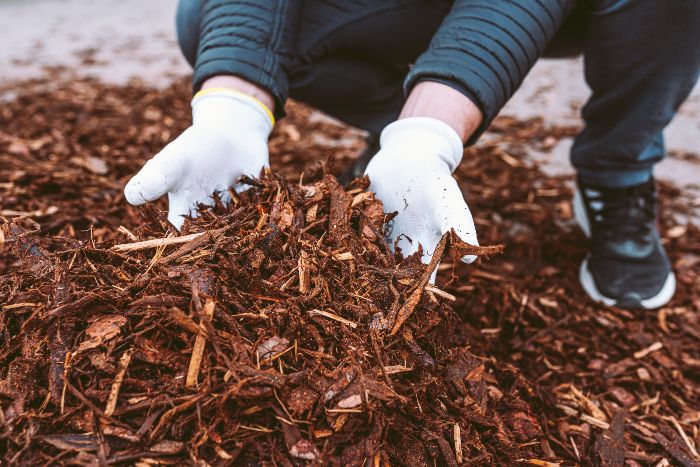As winter drags on, we shield ourselves from her chilly grip with layers of coats, scarves, and other warm garments. Much like people, trees also better survive frosty temperatures by layering up, but instead of clothing, they use mulch. Although mulching is good practice all year round, there are special reasons during the winter for fostering tree health and vitality. The guide below will cover the importance of winter mulching, compare winter and summer mulching, and discuss timing, materials, and other winter mulch tips!
Importance of Mulching
Before diving into the specifics of winter mulching, let’s first cover the year-round importance of mulching. Mulch acts as a protective layer around the base of trees, offering myriad benefits for tree root and soil health. It acts as an insulator, regulating soil temperature by keeping it cool in summer heatwaves and insulating against harsh winter chills. Mulch also retains soil moisture by preventing rapid evaporation, reducing irrigation needs, and preserving water resources. Additionally, it suffocates weeds and suppresses their growth, reducing competition for nutrients and water. Lastly, as mulch decomposes, it enriches the soil with organic matter, enhancing its fertility and structure.
Why Mulch in The Winter?
Mulching in the winter might seem counterintuitive, given the dormant state of many trees during this season. However, this practice can be highly beneficial for several reasons. Winter mulch acts as a protective barrier, shielding the tree’s root system from extreme temperature fluctuations. Sudden thaws followed by freezing temperatures can cause the soil to expand and contract, potentially damaging the roots. Mulch is a buffer, mitigating these temperature swings and safeguarding root tissues.
Additionally, winter mulch helps retain moisture in the soil, preventing dehydration during the colder months. While trees may not transpire water as actively in winter, the roots still require a steady supply. Mulch acts as a reservoir and shield, holding moisture and reducing evaporation so that water is available to the roots when needed.
Winter Vs Summer Mulching
While the principles of mulching remain constant throughout the year, there are some differences between winter and summer mulching. In the summer, mulch primarily regulates soil temperature, suppresses weeds, and retains moisture. In contrast, winter mulching protects against extreme temperature fluctuations and minimizes freeze-thaw cycles that may damage roots.

When Should You Apply Winter Mulch?
Although anytime is a good time to apply mulch, here are some suggestions if you live in a climate with winter temperatures below freezing. It’s recommended to apply winter mulch after the first frost. Applying it too early can insulate the soil, delaying the onset of dormancy and making the tree more susceptible to winter damage. Late fall or early winter, when the ground is sufficiently cold, is the optimal time for winter mulch application.
The goal here isn’t to prevent the ground from freezing but to hold it at a steady temperature around freezing to protect roots from extreme temperature changes. Be sure to avoid “volcano mulching” or piling mulch up around the trunk in a mound, which can trap excess moisture and harbor disease. Instead, apply mulch to the tree’s drip line in a 3-6” thick layer.
What Should You Use To Mulch In the Winter?
The mulch material you choose for winter mulching will affect the benefits the tree receives. Opt for woody, organic materials like wood mulch or wood chips to give trees the whole house of mulch benefits.
Wood mulch and wood chips consist of shredded bark and wood, often a valuable byproduct of tree trimming and removal operations. They provide a neat appearance while retaining soil moisture and insulating against wide temperature swings. Wood-based mulches release nutrients that feed the soil and the tree’s roots as they decompose. Other organic mulches like straw or leaves provide similar benefits, but due to their smaller size, they can compact and restrict air flow, harming root health. So, whenever possible, opt for wood-based mulch.
Inorganic mulches, such as rubber mulch, gravel, or landscape fabric, do not provide nutrients that promote tree health and growth. Rubber mulch is highly processed and may contain potentially harmful chemicals. Gravel and stone mulches fail to regulate temperatures and retain moisture. Landscape fabric hinders water, nutrients, and air penetration into the soil, reducing the tree’s access to many necessary resources. So get the most out of winter mulch using wood mulch, which you can request for free here!

Removing Winter Mulch
As spring approaches and temperatures rise, remove or reduce the thickness of winter mulch to avoid potential issues. Leaving thick mulch in place as temperatures warm can create a haven for pests and diseases. Ideally, keep mulch at a 2-4” depth and refresh with new mulch as needed.
Remove winter mulch gradually, starting from the outer edges and working your way toward the tree trunk. This allows the soil to warm progressively, promoting a smooth transition for the tree from dormancy to active growth.





